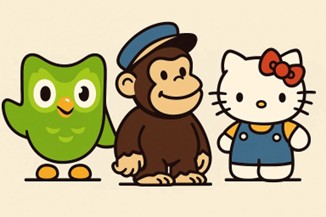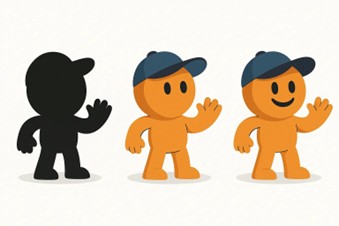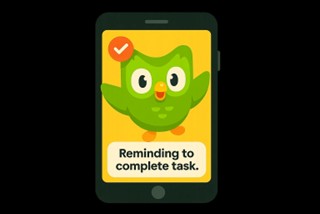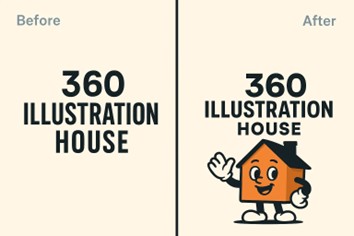As artificial intelligence continues to redefine the nature of customer interaction, content generation, and even brand management, some people are starting to feel like the brands that are relying on AI are losing the human touch. Automation certainly brings efficiency, but it's rarely as emotional as humans. This is where character, not code, becomes invaluable.
2D Characters are becoming indispensable resources for contemporary brands engaging in the digital realm. They provide what AI lacks: emotional relatability, visual novelty, and a brand distinction that is immediately recognizable, and something to anchor people emotionally. Brands are becoming more efficient with technology, and AI continues to diminish the personal aspects of brands, leaving 2D illustrations a great solution to bridge that gap.
In this blog, we look at how 2D characters are attracting attention for brands and how they remain emotionally relevant to our increasingly robot-like lives. We will explore storytelling attributes of 2D characters, their roles in branding, keeping long-term relationships, and the emergent business of developing and outsourcing 2D art. From basic sketches to highly developed mascots, 2D art development is in the process of becoming a branding leviathan to reckon with.
In a market where visuals and emotions drive decisions, faceless branding may come off as cold, generic, and easily forgettable. Today's consumers desire authentic and human interactions with brands they support.

Brands without a mascot tend to struggle to engage with their target audience. In the absence of a visual (and emotional) wedge, even the best products might get lost in the noise, or sea of sameness. However, brands that have characters or illustrated personas are more likely to win people’s attention, build a strong identity, and create loyalty.
Take Mailchimp’s quirky chimp mascot or Duolingo’s expressive green owl. These characters do more than entertain; they make interactions feel personal and fun. They act as friendly guides in the digital space, replacing sterile automation with something more animated and engaging.
So, what do mascots assist with? They provide a relatable identity to your brand. Be it unique storytelling, humor, or a recognizable image, mascots enjoy a much richer and relatable level of human representation of your brand's values and voice than any abstract logo or chatbot powered by AI will ever be able to express.
A well-designed mascot for brands acts like a consistent voice across support, social, and product UI. Let’s look at ways such characters humanize businesses:
Why do people connect more with a playful animated owl or a smiling soda bottle than with a polished brand statement?
The answer lies in anthropomorphism, our natural tendency to assign human traits to non-human things. When a brand uses a 2D character with facial expressions, gestures, and emotions, we subconsciously begin to treat it like a person. This makes the brand feel familiar, trustworthy, and emotionally accessible.
Illustrated characters simplify complex expressions. A frown indicates disappointment; a wink implies playfulness. Since visual simplicity and stylized features allow for easier emotional interpretation than hyper-realistic avatars, 2D characters effectively convey brand emotion. The interaction with the user becomes an experience, not merely an impression, like with AI.
If you want your character to feel truly human, here are a few design principles to keep in mind:

Before you sketch anything, think about what your brand stands for. Are you playful, professional, adventurous, or eco-friendly? A mascot should feel like a natural extension of that story. For example, a fun snack company can use a cheerful cartoon animal, while a tech startup could design a sleek robot.
The most effective mascots are the simple ones. Classic examples like the Michelin Man or the Pillsbury Doughboy are designed with simple shapes, easy lines, and clear features. A mascot should be recognizable even when drawn small or in black and white. Avoid adding too many details that could get lost when printed on packaging or resized for social media icons.
A good mascot should be easy to identify just by its outline. Designers call this a “strong silhouette.” If the character’s shape is entirely different, people can recognize it quickly without seeing all the details. Test your mascot in solid black to see if it still looks clear and unique. If it looks odd, simplify the design.
Colors play a big role in branding, so make sure your mascot’s color palette fits with your existing brand colors. If your brand is known for bold reds and yellows, the mascot should reflect that. At the same time, don’t overload it with too many colors—two or three main ones are usually enough. Colors should also look good both on screen and in print.
Expressions help people connect with your brand on a human level. Add big eyes, smiling mouths, or playful poses that make the character feel alive. A mascot that looks friendly and approachable will attract attention and leave a positive impression.
You won’t use your brand mascot once. It will appear in different formats: websites, ads, social media, merchandise, or even animations. So, design it with versatility in mind. Let’s say, you might need a simple “headshot” version for small icons and a full-body version for posters. As you scale, a dedicated 2d art development service can produce poses, expressions, and campaign-specific variants.
Who are you trying to reach? Kids respond well to bright, playful mascots, while adults might prefer something more sleek or witty. If your audience is international, avoid cultural symbols or humor that may not translate well. The mascot should speak the same “language” as your audience, visually and emotionally.
Sure, 3D renders and AI avatars are trending, but 2D characters still outperform in emotional storytelling, adaptability, and cost-efficiency.
Here’s why:
And while tech brands often lean toward futuristic interfaces, audiences still gravitate toward characters that feel real, because real humans designed them with emotion in mind.
Today’s audiences spend more time interacting with brands through websites, mobile apps, explainer videos, and social content, spaces where illustrated characters shine.
2D characters are often more than just static images; they often play the role of a brand's storyteller, teacher, and sometimes, even cheerleader. They appear in tutorials, relay promotional messages, mark milestones, and sometimes even help brands apologize when things go wrong.
What is the key to their success? Consistency in voice, visual identity, and emotional tone. The characters not only represent the brand, but they also speak for it.
For instance, a delivery app mascot may encourage you to re-order groceries in a friendly and humorous tone, while a fitness app character may greet you after you have completed a workout. These micro-interactions create emotional equity and attract an audience, without a human spokesperson.
As time goes on, 2D characters transition from being a marketing tool to brand personalities. These characters become recognizable to consumers, just as a jingle or tagline might become recognizable, and consumers begin to anticipate how the character will “react” in different situations. Will it be a joke when you cancel a cart? Will it wink when you hit your goal?
This predictability becomes comfort. It gives a brand human characteristics, even in the absence of a human.
And since the character represents the ideal persona of the company, it also remains constant across campaigns. No drama, or scandals, just on-brand and audience-approved communication.
No doubt, influencers and celebrity ambassadors still help build trust, primarily through testimonials and outreach in their various communities. However, their ability to do this typically comes into play in the arena of social proof or word of mouth.
In contrast, 2D characters can be scaled automatically, are ever-present across 7 days a week, and are easily tailored for any customer touchpoint.
Both work in a complementary ecosystem, where human voices are viewed to provide credibility, while illustrated, 2D mascots provide consistency, creative difference, and long-term brand equity.
More importantly, the role of 2D characters in today's digital branding space must also be viewed as a relentless, engaging, and memorable voice that customers actually want to hear from.
The real test of a branding strategy is versatility, and 2D characters have consistently proved their worth and value in innumerable brand situations, not just as cute characters. From onboarding flows to full-blown digital ecosystems, these illustrated characters have gone beyond being mascots and are now branding infrastructure.

Now, let's look at some of the ways or use cases in which 2D character design in today's fast paced, digital-first world, has been useful and effective.
The most productive role of 2D characters is found in apps and platforms that have habit formation as a goal. Education and fitness apps are two great examples. Instead of instilling guilt or experience index dashboards devoid of personality, these brands utilize 2D characters to model, motivate, and reward users in inviting and customized ways.
Duo the Owl from Duolingo is likely the most famous modern-day example of this practice. Duo is an avatar, but he is a character too, with a personality that serves as a taskmaster, encouragement, and social guilt with some sass. This has cemented Duolingo's status as one of the most compelling learning apps globally.
Similarly, productivity apps like Habitica use RPG-style 2D avatars to gamify personal habits. Users earn points, unlock customizations, and “level up” their illustrated character as they progress through goals. The visual journey adds tangible emotion to digital progress, which text alone cannot achieve.
E-commerce brands are increasingly using 2D characters to breathe life into otherwise flat online shopping experiences. While photos show the product, characters show the personality behind the brand.
For example, skincare and cosmetic brands like Glossier have used hand-drawn 2D avatars in limited-time campaigns to embody their “cool girl” aesthetic. Rather than relying on product photography alone, these characters represent their customers’ aspirations, tone, and lifestyle, leading to stronger emotional connections.
Toy and merchandise companies take this a step further. Brands like Sanrio (Hello Kitty) and Funko Pop have built entire product lines around their original 2D characters. These mascots aren’t just part of the brand; they are the brand. Every campaign, from product drops to event marketing, is anchored in the universe of these characters.
In software and web applications, users often need guidance to navigate new systems or make decisions. Rather than relying solely on tooltips or technical documentation, many modern apps now introduce 2D characters as in-app assistants.
Take Mailchimp’s Freddie , for instance. Freddie frequently appears with playful expressions and helpful messages, guiding users through email automation flows or campaign reports. He adds levity to an otherwise dry, data-heavy experience, creating an emotional hook that keeps users engaged and coming back.
SaaS platforms and fintech tools increasingly use these characters during onboarding, system alerts, and even error messages. Why? Because even a bug feels less frustrating when a quirky, friendly character is there to apologize.
Explainer videos remain one of the most effective ways to introduce complex products to new audiences. And who better to walk the viewer through it than a 2D mascot?
Animated characters are frequently used in motion graphics videos to simplify abstract ideas, like how a blockchain works, or why a certain insurance plan matters. These characters are approachable, flexible in tone, and capable of shifting between humor and clarity.
On platforms like Instagram Reels, TikTok, and YouTube Shorts, where attention spans are fleeting, brands are increasingly using short, episodic content featuring their mascots. These quick clips become storytelling gold, entertaining users while subtly reinforcing product benefits.
A great example? Barbie. Though traditionally known as a doll, the brand has transformed Barbie into a full-blown digital influencer, complete with animated skits, fashion tips, and day-in-the-life content, all told through short-form 2D videos.
It’s no surprise that children connect best with characters, especially when learning is involved. 2D characters are central to early education platforms, apps, and even physical learning tools.
Platforms like ABCmouse and Khan Academy Kids use entire casts of friendly 2D characters to teach letters, numbers, and social skills. These characters don’t just make lessons fun; they create trust. Kids see them as companions, and parents see them as educators.
Beyond the screen, publishing brands use 2D mascots to extend the classroom into books, posters, and learning materials. Retention improves dramatically when a child learns multiplication from a character they know and like.
Even in B2B, which is often characterized by a stern and formalized branding approach, at least 2D characters are starting to shine through. Technology companies and SaaS (software as a service) brands are realizing that people are making purchases from people, even in enterprise deals.
A friendly 2D mascot can help alleviate the friction in a difficult conversation contained within pitch decks, explainer slides, or landing pages. Rather than relying solely on large walls of written copy, 2D characters offer more just visual metaphors for pain points, solutions, or benefits. They humanize the service while maintaining a degree of professionalism and distance.
Brands that are going global find 2D illustrated characters even more useful because of their cultural neutralizer status. A strong 2D character can transcend boundaries of geography, language, and social norms better than photography or video of actual people.
In wellness spaces, especially those involving sensitive emotions, 2D characters help reduce tension and increase relatability. Mental health apps like Headspace use warm, friendly animations to guide users through meditation and mindfulness exercises. These characters feel safe, inviting, and non-judgmental.
In physical health, 2D mascots often simplify complex processes. For example, health insurance companies or pediatric hospitals use them to explain vaccines, surgeries, or routines in ways that are easy for children and families to understand.
AI can handle scheduling, automation, and even creative tasks, but it can’t make your customers smile or engage them. That’s why your band requires 2D characters. They act as the “face” your brand might be missing, are easy to recognize, easy to relate to, and are full of personality.
A character 2D design can guide a new user through your app without feeling like another cold tutorial, or soften the frustration of an error message with a wink and a grin. It’s those small, human touches that make the difference between being remembered and being forgotten.
Brands like Duolingo and Mailchimp have proven that when a character shows up consistently, people don’t just use the product—they form a relationship with it. In other words, AI efficiency alone won’t create customer loyalty. Hire a good designer for a 2D mascot that makes sure your brand still feels alive, approachable, and genuinely human.

Looking for more information? Call us at +1 (855) 521-5040 for quick support!






Have a project in mind? Reach out to us, and we’ll help turn your ideas into stunning illustrations.
Tell us what you need, and we’ll create a custom illustration just for you. Reach out today and let's get started!

Copyright © 2025 360 Illustration House | All rights reserved. Terms And Conditions | Privacy Policy | Refund Policy
